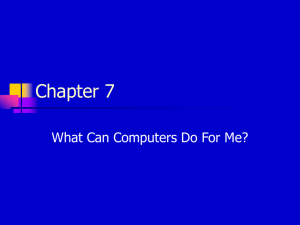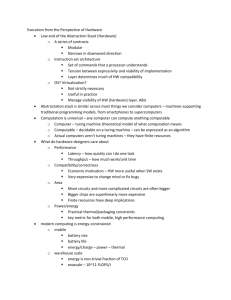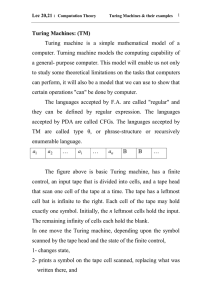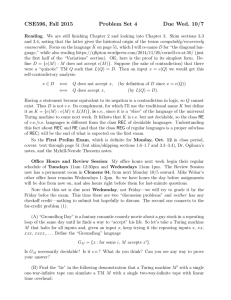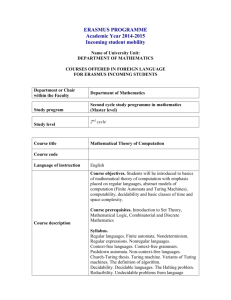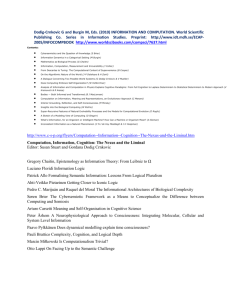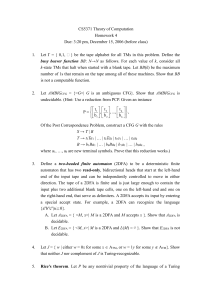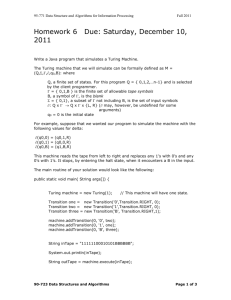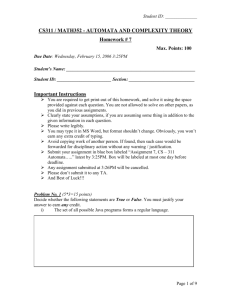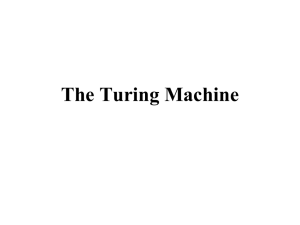Computation for Physics
advertisement
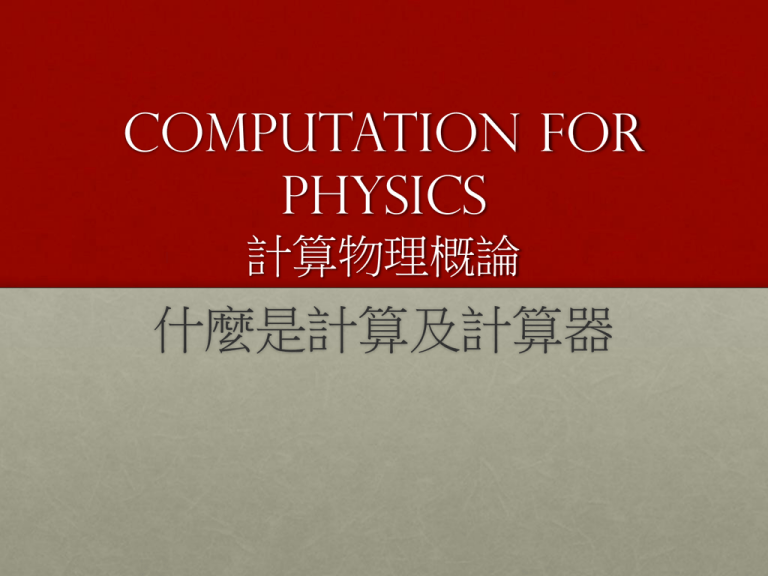
Computation for Physics 計算物理概論 什麼是計算及計算器 基本資料 • 教師:陳柏中 Pochung Chen • 物理館 R521,理論中心 R510 • pcchen@phys.nthu.edu.tw • http://qubit.phys.nthu.edu.tw/~pcchen (選 Teaching) • 助教:張博勝 • phybd44@gmail.com • 上課時間:R5R6R7 (1:20pm-16:40pm) • 上課地點:物理館019 or 計中 2F 電一教室 評量方法 • 作業成績 • 期末報告或計畫 • 課堂表現 課程目標 • 了解電腦基本架構 • 學習使用程式語言 (Python) • 學習使用應用軟體 (Sage Math) • 學習使用電腦解決物理問題 課程大綱 • Introduction to computers • Introduction to UNIX-like environment • Introduction to programming languages • Introduction to software • Introduction to algorithms • Introduction to computational physics • Information society 資訊社 Weekly Schedule • Week 1: 2/21 Lecture • Week 9: 4/18 Lab-4+Lecture • Week 2: 2/28 (No class) • Week 10: 4/25 Lab-5+Lecture • Week 3: 3/7 Lecture • Week 11: 5/2 Lab-6+Lecture • Week 4: 3/14 Lab-1 • Week 12: 5/9 Lab-7+Lecture • Week 5: 3/21 Guest lecture: • Week 13: 5/16 Lab-8+Lecture • 李士傑「資訊與社會:什麼 • Week 14: 5/23 Lab-9+Lecture 是自由?」 • Week 6: 3:28 Lab-2+Lecture • Week 15: 5/30 Lab-10+Lecture • Week 7: 4/4 (No class) • Week 16: 6/6 Lab-11+Lecture • Week 8: 4/11 Lab-3+Lecture • Week 17: 6/13 Lab-12+Lecture • Week 18: 6/20 (Final week) Experiment, Theory, Simulation Simulation Experiment Theory What is Computation? From Wikipedia • Computation is any type of calculation or use of computing technology in information processing. • Computation is a process following a well-defined model understood and expressed as, for example, an algorithm, or a protocol. • Computational physics is the study and implementation of numerical algorithms to solve problems in physics for which a quantitative theory already exists. It is often regarded as a subdiscipline of theoretical physics but some consider it an intermediate branch between theoretical and experimental physics. • The study of the physics of computation relates to understanding the fundamental physical limits of computers. This field has led to the investigation of how thermodynamics limits information processing, the understanding of chaos and dynamical systems, and a rapidly growing effort to invent new quantum computers. Introduction to Computer • A computer is a general purpose device that can be programmed to carry out a finite set of arithmetic or logical operations. Since a sequence of operations can be readily changed, the computer can solve more than one kind of problem • The Zuse Z3, 1941, considered the world's first working programmable, fully automatic computing machine. Computing Hardware • Computing hardware evolved from machines that needed separate manual action to perform each arithmetic operation, to punched card machines, and then to storedprogram computers. The history of stored-program computers relates first to computer architecture, that is, the organization of the units to perform input and output, to store data and to operate as an integrated mechanism. 算盤 Abacus • As an aid to calculation • No automation Pascaline • 1642-1645: Prototype period. • First mechanical calculator that can perform automatically the basic operations of arithmetic http://www.youtube.com/watch?v=3h71HAJWnVU Blaise Pascal 6/19/1623–8/19/1662 Arithmomètre • Patented in France by Thomas de Colmar in 1820 and manufactured from 1851 to 1915. It become the first commercially successful mechanical calculator. • Operations: • • • • • • Sliding the Top Carriage Addition Multiplication Subtraction Integer division Decimal division • http://www.arithmometre.org/ http://www.youtube.com/watch?v=s2T_158Es Ow http://www.youtube.com/watch?v=v6niUVf0d Difference engine • A difference engine is an automatic mechanical calculator designed to tabulate polynomial functions. The name derives from the method of divided differences, a way to interpolate or tabulate functions by using a small set of polynomial coefficients. • Babbage's difference engine No. 2, finally built in 1991, could hold 8 numbers of 31 decimal digits each and could thus tabulate 7th degree polynomials to that precision. The best machines from Scheutz could store 4 numbers with 15 digits each. http://www.youtube.com/watch?v=0anIyVGe Charles Babbage, 12/26/1791– 10/18/1871 Analytical engine • Programmable mechanical general-purpose computer • It incorporated an arithmetic logic unit, control flow in the form of conditional branching and loops, and integrated memory • The input (programs and data) was to be provided to the machine via punched cards • For output, the machine would have a printer, a curve plotter and a bell. The machine would also be able to punch numbers onto cards to be read in later. • There was to be a store (that is, a memory) capable of holding 1,000 numbers of 40 decimal digits each (ca. 16.7 kB). • Never built Atanasoff–Berry Computer 1942 • One of the first electronic digital computing devices • Not programmable • Parallel processing • Binary arithmetic • Regenerative capacitor memory • Separation of memory and computing functions http://www.youtube.com/watch?v=YyxGIbt MS9E Colossus computer 1944 • World's first electronic, digital, programmable, singlepurpose computer with variable coefficients. Harvard Mark I 1944 • Electro-mechanical computer. • Program-controlled by 24-channel punched paper tape. ENIAC 1946 • Electronic Numerical Integrator And Computer • First electronic general-purpose computer • Turing-complete, digital, and re-programmable to solve a full range of computing problems. • ENIAC contained 17,468 vacuum tubes, 7,200 crystal diodes, 1,500 relays, 70,000 resistors, 10,000 capacitors and around 5 million hand-soldered joints. It weighed more than 27 t, was roughly 2.4 m × 0.9 m × 30 m, took up 167 m2, and consumed 150 kW of power. • The need of a stored-program computer Alan Turing • Alan Mathison Turing, 6/23/1912 – 6/7/1954 • Universal Turing machine • Algorithm • Computation • Criminal prosecution in 1952 due to his homosexuality • British Prime Minister Gordon Brown made an official public apology on behalf of the British government for "the appalling way he was treated” in 2009. Turing Machine Turing Machine • A tape divided into cells, one next to the other. Each cell contains a symbol from some finite alphabet. The alphabet contains a special blank and one or more other symbols. The tape is assumed to be arbitrarily extendable to the left and to the right. Cells that have not been written to before are assumed to be filled with the blank symbol. • A head that can read and write symbols on the tape and move the tape left and right one cell at a time. • A state register that stores the state of the Turing machine, one of finitely many. There is one special start state with which the state register is initialized. • A finite table of instructions (usually 5-tuples : qiaj→qi1aj1dk) that, given the state(qi) the machine is currently in and the symbol(aj) it is reading on the tape tells the machine to do the following in sequence: • • • Either erase or write a symbol (replacing aj with aj1), and then Move the head (which is described by dk='L’, 'R’, or 'N’), and then Assume the same or a new state as prescribed (go to state qi1). • Universal Turing machine=a Turing machine that can simulate an arbitrary Turing machine on arbitrary input. Von Nuemann Model Generations • 1st generation : Vacuum tubes • 2nd generation : Transistor • 3rd generation : Integrated Circuit (IC) • 4th generation : Microprocessor + (LSI, VLSI) How to program? • Machine code: • Instructions executed directly by CPU • Loads the AL register with the data 01100001 • 10110000 01100001 • B0 61 • Assembly: • Low-level programming language • Statement (Assembler) Machine code instruction • Loads the AL register with the data 01100001 • MOV AL, 61h ; Load AL with 97 decimal (61 hex) High-level programming language • Strong abstraction • Natural language elements • Interpreted language • Compiled language program helloworld print *, "Hello, world." end program helloworld Operating System • A collection of software that manages computer hardware resources and provides common services for computer programs • Acts as an intermediary between programs and the computer hardware UNIX • A multitasking, multi-user computer operating system originally developed in 1969 by a group of AT&T employees at Bell Labs • First developed in assembly language • By 1973 had been almost entirely recoded in C • X-Windows Unix and UNIX-Like Open Source/Free • GNU and FSF • Linux • Free BSDs GNU Project • GNU’s Not Unix • A free software, mass collaboration project, announced on 27 September 1983, by Richard Stallman at MIT General Public Licence • GPL is the most widely used free software license, which guarantees end users (individuals, organizations, companies) the freedoms to use, study, share (copy), and modify the software. Linux • The History of Linux began in 1991 with the commencement of a personal project by a Finnish student, Linus Torvalds, to create a new free operating system kernel. Linux Distribution

